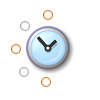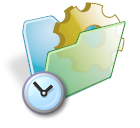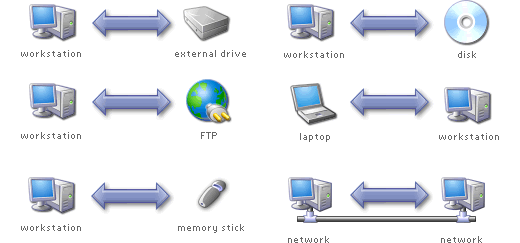Introduction
Everyone who uses a computer to save or store files will at some time or another experience that heart stopping moment when they realize their files are lost.

Don't let those files be lost forever. It's plain and simple: if you use a computer, you need to backup your data. It's not a question of whether you should, but rather how you should...
Why Backup?
Every day individuals, businesses, and organizations lose their precious files due to a drive failure, inadvertent deletion, or other unwanted action or event. The result is a great deal of stress, anxiety, and in the case of businesses, lost revenue.
The computer hard drive that stores all your data has moving parts, and in time your hard drive will wear out and fail. It's just a matter of when. You need to keep a copy of all your important data somewhere else.

Apart from hard drive failure, there are many other likely scenarios that may result in the loss of your valuable files like power failures and spikes, or system and file corruption due to viruses, worms, or other malicious attacks.
Backup Location
| You need to store a copy of all your important files in a different location to where your computer is situated. It's not a great deal of use having the copy of your files on your external hard drive which is constantly plugged into your computer. A thief won't leave your additional drive for you to recover your lost files, a fire or flood won't distinguish between your computer and your external drive. At the very least, keep your copy in a different location in your home. If possible, keep your backup copy in an entirely different building. Some choose to backup their data onto remote servers via File Transfer Protocol (FTP) or by other means. Others use the services of off-site backup over the Internet. Be mindful however that your data is your responsibility. The moment you transfer that data to a third party to keep safe, new risks involving the potential compromise of that services' availability and security arise. |  |
The Ultimate Backup
 | There are circumstances when a backup might also be inadvertently corrupted or over-written. Regularly creating a third backup stored in a different location, although less convenient to administer, provides you with the greatest security against losing your data. If however you are unlikely to backup often to this third location, it's not going to be worth your while as a backup needs to be updated frequently to be of any value. |
What Data Should Be Backed Up?
In addition to your pictures, videos, music, Microsoft ® Office documents, spreadsheets, databases, Internet Explorer Favorites and/or Firefox bookmarks, emails etc, you'll also want to keep a copy of all the programs you use so that if necessary they may be easily reinstalled at a later date. It would be advisable therefore to copy any new programs you download and install them from the Internet in a special folder that gets backed up as part of your backup routine.

One especially important program to backup is the program you use for the backup procedure itself. You'll also need to save the serial number for this program and others in a secure yet memorable location so you can restore your backup to the original location at a later date should you need to.
If you use your computer for business purposes you will also need to backup all the information from your financial software, inventory control, customer databases, and other specialist business files.
Finding Your Files
Here are some directions of a few places you can check for where your important files are stored. Note that systems may have been set up differently and you may need to take a little time to find the location of particular files on your computer. If you experience difficulties use the Windows search tool available by going to Start > Search.
For the average user there are two main locations where you will probably backup files from: My Documents which will most likely contain your day to day files like Word files etc., and Application Data which stores application specific settings and files.
One of the easiest ways to locate My Documents is to open Windows Explorer by right clicking Start then clickingExplore from the pop-up menu. At the top left of the Explorer window (see below) you will see the My Documents folder underneath the Desktop icon. You can now use the "+" and "-" signs to explore the folders:

The Path to Your Application Data
drive:\Documents and Settings\All Users\Application Data
Note how the path above to the Application Data is different than the illustration that follows for Outlook Application Data. You will need to check how your own system is configured. This will simply be a matter of using Windows Explorer.
Outlook Personal Folders Files (.pst)
The Personal Folder file (.pst / PST) is the place where Outlook stores its data (when you're using Outlook without Microsoft® Exchange Server).
Each Personal Folder file contains all of your Outlook folders, including the In box, Calendar, and Contacts. You may have a single .pst file (usually called Internet Folders or Personal Folders in your Folder List), and you may also have an additional .pst file that you use to archive messages (named Archive Folders). By backing up these PST files you will be backing up all your Outlook information.
You can find the location of the main PST file by right-clicking on the Outlook Today icon found in your Outlook shortcuts, or the Outlook Today icon found in your folder list and then left-clicking Properties. Once the Properties dialog box is displayed, click the Advanced button.
The Path... shown indicates where your Personal Folder file can be found. An example path follows:
drive:\Documents and Settings\User\Local Settings\Application Data\Microsoft\Outlook\Outlook.pst
Each Personal Folder file contains all of your Outlook folders, including the In box, Calendar, and Contacts. You may have a single .pst file (usually called Internet Folders or Personal Folders in your Folder List), and you may also have an additional .pst file that you use to archive messages (named Archive Folders). By backing up these PST files you will be backing up all your Outlook information.
You can find the location of the main PST file by right-clicking on the Outlook Today icon found in your Outlook shortcuts, or the Outlook Today icon found in your folder list and then left-clicking Properties. Once the Properties dialog box is displayed, click the Advanced button.
The Path... shown indicates where your Personal Folder file can be found. An example path follows:
drive:\Documents and Settings\User\Local Settings\Application Data\Microsoft\Outlook\Outlook.pst
Outlook Express
Go to the Outlook Express menu and select Tools > Options > Maintenance then click the Store Folder button. You'll see a dialog with the name of the directory that has your mail files. If you look in that directory you'll find files named after your mail folders and news groups. They all have a .DBX suffix. All your Outlook Express messages are kept in these database files. If you make copies of these files regularly, you'll have a safe backup of your OE mail.
Internet Explorer Favorites
Right click Start > Explore. When Windows Explorer opens go to Tools > Folder Options > View. Select Show hidden files and folders, then go to drive:\Documents and Settings\User Name\Favorites. You may need to right click unhide.
Mozilla Firefox
All bookmarks are stored in a file called bookmarks.html and is stored in the profile folder, a typical example being:
Documents and Settings\All Users\[Log-in Name]\Application Data\Mozilla\Profiles\
Disk Imaging
To make an exact copy of your drive, including your Windows operating system, you must use 'disk imaging' software. Disk imaging copies the entire disk (the parts that are used) bit-by-bit. This results in a copy that will take up a lot of disk space, and take much longer to copy.
 | Disk imaging isn't generally the best answer to backing up for a number of reasons. |
Your Windows operating environment is constantly changing. Programs are installed, updated, uninstalled, and settings are changed. Many important security specific applications are also regularly and automatically updated. Anyone for example who users their computer to connect to the Internet should have in place Anti-Virus, Firewall, and Anti-Spyware programs that often update many times a week.
Another significant reason why creating a disk image of your drive is not an advisable routine backup procedure is that any and all misconfigurations of your system, dormant security threats, and the vast amount of junk data that is created and stored on your system, will also be copied. Much of this junk data cannot be deleted as it is generated behind the scenes in your system. This results in a decrease in performance and speed, and can also lead to system instability.
Lastly if you change your computer then it's very possible that you won't be able to restore from a disk image as that disk image contains all the drivers and settings for your previous computers hardware, which is probably completely different (e. g. different motherboard).
These issues, combined with the much longer, costlier (more disks), and less convenient (more time consuming) disk imaging process inevitably means that for the average user, disk imaging is carried out far less frequently than the kind of backup that only copies your documents and information (usually under the 'My Documents' folder). Always remember that making regular backups to a different location is the key to an effective backup strategy.
People who use disk imaging often use file backup programs as well. For example, they take a snapshot of their hard disk using the disk imaging software, e. g. every week, month, or at ad-hoc times, but use the file backup program to make regular backups of their important files, e. g. scheduled every day or even hourly. When doing a restore they first restore the disk image then restore their files using the file backup program.
How Often Should You Make a Backup of Your Files?
 | If you work on your documents each day, you need to backup at least once a day. If you accidentally delete a file, or a program crashes while you're working on a document, you need to be in a position where you can click a button to recover that file from your backup copy, so you may well want to run the backup program in the background. The more impressive backup programs can also copy open and locked files so that a backup can be made even when you're working on a document. |
Many people benefit from backing up on a very regular basis throughout the day. Writers for example may be working on a draft and may wish to review an earlier version of that draft as they progress. This kind of incremental backup is also possible depending on the backup software you use so that you can effectively roll-back to an earlier version of your document.
What Should You Backup Onto?
There are many different types of media that you may choose to backup onto, and each has their own advantages and disadvantages. The first thing you'll have to work out is what suits your particular circumstance.

It's generally a good idea to choose media that allows you to backup all the data you wish to without having to 'span' the backup. For example, you may need many CDRs to backup all your information. The problem with this kind of backup is that it requires your intervention to replace the new media as each disk is required. A backup that can automatically run without your intervention will save you a great deal of time over the long run. An external USB hard drive for example can plug straight into a computer and provide an instant large capacity space for your backups.
If you're a personal computer user the most immediate medium you're probably going to consider is to backup to CDR/W or DVDR/W, however these mediums are also less stable over longer periods of time than you might realize. For pure convenience there's nothing easier than making relatively small capacity backups to a USB memory stick that you can easily plug in, and then transfer to another location. If you're a business with existing backup procedures, you may be using tape backup (which can be sensitive to heat, magnetism etc), or you may be implementing a removable hard disk procedure.
Whatever you choose make sure your chosen media is easy to use, requires as little intervention as possible, and can easily be scheduled.
Improving Backup Procedures
If you already have a backup routine it's prudent to check it's doing what you expect, and if necessary, to make adjustments to ensure it's performing to your best advantage. Take care to read through and understand the documentation that comes with your backup program as there may be specific customizations that you may wish to make. For example, you may want to configure your backup so that the program verifies that files are copied correctly, and that the backup makes safe copies by using temporary file names before renaming the file given the copy is successful.
Some backup programs assist you in the evaluation of effective backup procedures by allowing you to test any backup you do with a simulated run. This allows you to check the backup routine functions correctly without actually copying any files.
Scheduling Backups
 | It's very easy to have your important files backed up without you having to remember to do so. The backup can be done automatically, every day, while you sleep. It can be done while you're on holiday or out of the office. Computers are designed to help automate tasks, so let your computer and software automate your backups. |
The Solution to Backing Up
 |  | There's a simple solution to ensuring a backup copy of all your important files has been created so that if an unfortunate event occurs that results in the unwanted loss of your data, it's easy to restore that data. This may be a single file that you've inadvertently deleted, or all the documents you've worked on or stored at one time or another. |
SyncBackSE and SyncBackPro from www.2brightsparks.com allows users to easily and automatically backup any file you write to (Word, image, media etc.). These multi-award winning programs can even backup open and locked files which means your files can be backed up as you're working. Other highlights include: Fast Backup and Smart Synchronization; Powerful FTP engine & AES encryption; Superb Feature-Set and Customization; Generous Licensing Policy; and Extensive Help Documentation.
The flagship product, SyncBackPro provides even more great advantages: backup to CD/DVD with disk spanning; backup to your email account; configure the program and profiles using your own script; a higher compression rate than Zip making FTP and email backups faster, and lessening the load on network backups; and S.M.A.R.T. Warnings that check for drive warnings or failure.
Synchronization
As well as backing up and restoring your data, SyncBackSE can also allow you to safely and easily synchronize files between two different directories. Those files could be on different drives, different computers, different devices, or even over the Internet via FTP.
You perform a backup when you want to keep a second copy of your files. A backup doesn't change your original files. If you accidentally delete a file, or make changes you don't want, etc. then you can restore the original file from the backup.
When synchronizing however, you are copying files between two computers or storage mediums, e.g. your hard disk and an external USB drive. Perhaps you've got a desktop computer and a notebook computer and have copies of the same files on both computers. You may be changing those files either on your desktop or notebook depending on the situation. With synchronization, files are copied from one to the other based on when they were last changed. Files may also be deleted, e.g. you delete a file on your notebook and so want the same file on your desktop to be deleted.
The following graphic shows different synchronizing scenarios:

This additional functionality and outstanding customization of SyncBackSE, together with an industry leading online Support Area and superb help file, sets this program apart from the competition.
Conclusion
Backing up your data is your one essential task. If you haven't tried SyncBackSE, download the free trial today from www.2brightsparks.com. Whatever you do, backup each and every day from here on in, and don't be one of those many who at this very moment are wishing they had....
